
(a)
Interpretation:
The complete, detailed mechanism and the major product of the given reaction are to be drawn.
Concept introduction:
Answer to Problem 20.3P
The complete mechanism of the reaction can be drawn as

The major product of the reaction is
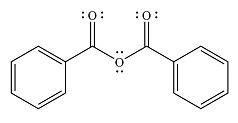
Explanation of Solution
The given reaction is
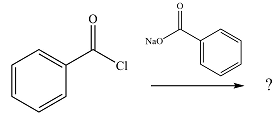
The substrate is an acid chloride, the least stable of the carboxylic acid derivatives. It will, therefore, undergo an acyl substitution via nucleophilic addition-elimination to form an acid anhydride.
The reagent is ionic, and essentially behaves as a negatively charged nucleophile, a carboxylate anion. It will attack and add to the electrophilic carbonyl carbon from the acid chloride. This will result in the formation of a tetrahedral intermediate, with the negative charge on the carbonyl oxygen of the substrate.

In the next step, the leaving group, chloride ion is eliminated to form the product.

The product is more stable than the substrate, therefore, the reaction will occur.
Thus, the complete mechanism can be drawn as

And the major product of the reaction ss

The mechanism and the major product of the given reaction were determined based on nucleophilic addition-elimination provided the possible product is of comparable or higher stability.
(b)
Interpretation:
The complete, detailed mechanism and the major product of the given reaction are to be drawn.
Concept introduction:
Carboxylic acid derivatives undergo acyl group substitution reactions when treated with appropriate nucleophiles. The reaction occurs via nucleophilic addition-elimination involving a tetrahedral intermediate. It may also involve proton transfer step(s). The reaction occurs if the possible product is more stable than the reactant. If the two are of comparable stability, the reaction will occur reversibly. The order of increasing stability of acid derivatives is
Answer to Problem 20.3P
The complete mechanism of the reaction can be drawn as

The major product of the reaction is

Explanation of Solution
The given reaction is

The substrate is an acid anhydride and the reagen is essentially the anionic nucleophile
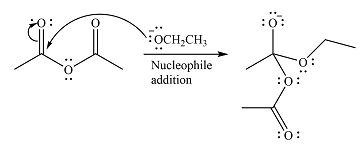
The second step is nucleophilic elimination. The acyl group from the original anhydride is eliminated to form the product, an ester.

Thus, the complete mechanism can be drawn as

Since an ester is more stable than an acid anhydride, the reaction will occur, and the major product will be

The mechanism and the major product of the given reaction were determined based on nucleophilic addition-elimination provided the possible product is of comparable or higher stability.
(c)
Interpretation:
The complete, detailed mechanism and the major product of the given reaction are to be drawn.
Concept introduction:
Carboxylic acid derivatives undergo acyl group substitution reactions when treated with appropriate nucleophiles. The reaction occurs via nucleophilic addition-elimination involving a tetrahedral intermediate. It may also involve proton transfer step(s). The reaction occurs if the possible product is more stable than the reactant. If the two are of comparable stability, the reaction will occur reversibly. The order of increasing stability of acid derivatives is
Answer to Problem 20.3P
The complete mechanism of the reaction can be drawn as

The major product of the reaction is
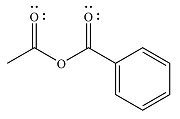
Explanation of Solution
The given reaction is
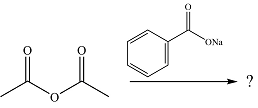
The substrate is an anhydride, with electrophilic carbons. The reagent is an ionic compound, which will essentially act as an anionic nucleophile, a carboxylate ion.
In the first step, the carboxylate ion will add to one of the carbonyl carbons of the anhydride. This will result in the formation of a tetrahedral intermediate with the negaive charge shifting to the ccorresponding carbonyl oxygen.
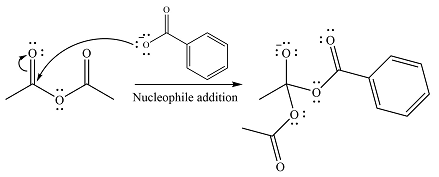
In the next step, the leaving group will be liminated as a carboxylate anion.
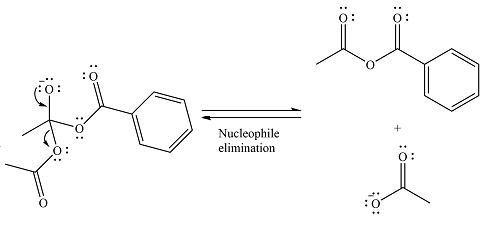
The major product is another acid anhydride of comparable stability. This means the reaction will occur, with reversible addition and elimination steps.
Thus, the complete mechanism can be drawn as

Thus, the major product will be

The mechanism and the major product of the given reaction were determined based on nucleophilic addition-elimination provided the possible product is of comparable or higher stability.
(d)
Interpretation:
The complete, detailed mechanism and the major product of the given reaction are to be drawn.
Concept introduction:
Carboxylic acid derivatives undergo acyl group substitution reactions when treated with appropriate nucleophiles. The reaction occurs via nucleophilic addition-elimination involving a tetrahedral intermediate. It may also involve proton transfer step(s). The reaction occurs if the possible product is more stable than the reactant. If the two are of comparable stability, the reaction will occur reversibly. The order of increasing stability of acid derivatives is
Answer to Problem 20.3P
There is no reaction.
Explanation of Solution
The given reaction is
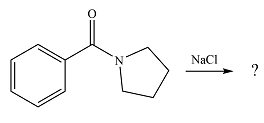
The substrate is a highly stable amide. If the
Since the possible product is of lower stability than the substrate, the reaction will not occur.
The reaction will not occur if the possible product is of lower stability than the susbtrate.
(e)
Interpretation:
The complete, detailed mechanism and the major product of the given reaction are to be drawn.
Concept introduction:
Carboxylic acid derivatives undergo acyl group substitution reactions when treated with appropriate nucleophiles. The reaction occurs via nucleophilic addition-elimination involving a tetrahedral intermediate. It may also involve proton transfer step(s). The reaction occurs if the possible product is more stable than the reactant. If the two are of comparable stability, the reaction will occur reversibly. The order of increasing stability of acid derivatives is
Answer to Problem 20.3P
There is no reaction.
Explanation of Solution
The given reaction is

The substrate is an ester while the possible product of the reaction would be an acid anhydride. Since an ester is more stable than an acid anhydride, the reaction will not occur.
The reaction will not occur if the possible product is of lower stability than the susbtrate.
(f)
Interpretation:
The complete, detailed mechanism and the major product of the given reaction are to be drawn.
Concept introduction:
Carboxylic acid derivatives undergo acyl group substitution reactions when treated with appropriate nucleophiles. The reaction occurs via nucleophilic addition-elimination involving a tetrahedral intermediate. It may also involve proton transfer step(s). The reaction occurs if the possible product is more stable than the reactant. If the two are of comparable stability, the reaction will occur reversibly. The order of increasing stability of acid derivatives is
Answer to Problem 20.3P
The complete mechanism of the reaction can be drawn as

The major product of the reaction is
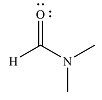
Explanation of Solution
The given reaction is

The substrate is an ester, with an electrophilic carbonyl carbon. The reagent is essentially an anionic nucleophile
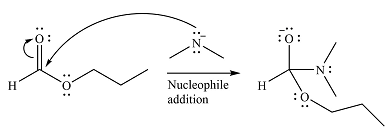
In the second step, the alkoxide group from the original ester will be eliminated to form the product, an amide.

Since the product is more stable than the substrate, the reaction will occur.
Thus, the complete mechanism can be drawn as

And the product of the reaction will b

The mechanism and the major product of the given reaction were determined based on nucleophilic addition-elimination provided the possible product is of comparable or higher stability.
Want to see more full solutions like this?
Chapter 20 Solutions
EBK GET READY FOR ORGANIC CHEMISTRY
- [In this question, there are multiple answers to type in a "fill-in-the-blank" fashion - in each case, type in a whole number.] Consider using Slater's Rules to calculate the shielding factor (S) for the last electron in silicon (Si). There will be electrons with a 0.35 S-multiplier, electrons with a 0.85 S-multiplier, and electrons with a 1.00 S-multiplier.arrow_forwardProvide the unknown for the given data.arrow_forwardDraw the Lewis structures of two methanol (CH3OH) molecules and depict hydrogenbonding between them with dashed lines. Show all lone pairs. Provide a thorough analysis to apply concept idea into other problems.arrow_forward
- Steps and explanation please.arrow_forwardHow could you distinguish between each pair of compounds below using IR? For each pair citeone bond and it’s frequency that you could use to distinguish between them. Please provide thorough analysis to apply into further problems.arrow_forwardSteps and explanation please.arrow_forward
- Provide the unknown for the given dataarrow_forwardProvide the unknown for the given data.arrow_forwardElectron Arrangement A. Fill in the following chart relating to levels, sublevels and orbitals. Levels (n) 1 Sublevels # of Orbitals per sublevel 2 3 4 # of Electrons per sublevel Total Electrons per level Complete: B. Answer the following questions related to levels, sublevels, orbitals and electrons. 1. How many sublevels are in energy level 2? 2. How many orbitals are in a 4f sublevel? 3. How many electrons can level 3 hold? 4. How many orbitals are in level 4? 5. How many electrons can sublevel 2p hold? 11arrow_forward
 Organic Chemistry: A Guided InquiryChemistryISBN:9780618974122Author:Andrei StraumanisPublisher:Cengage Learning
Organic Chemistry: A Guided InquiryChemistryISBN:9780618974122Author:Andrei StraumanisPublisher:Cengage Learning
